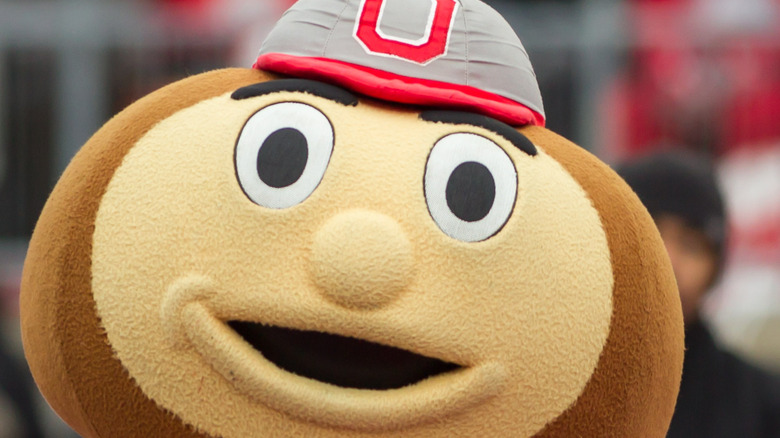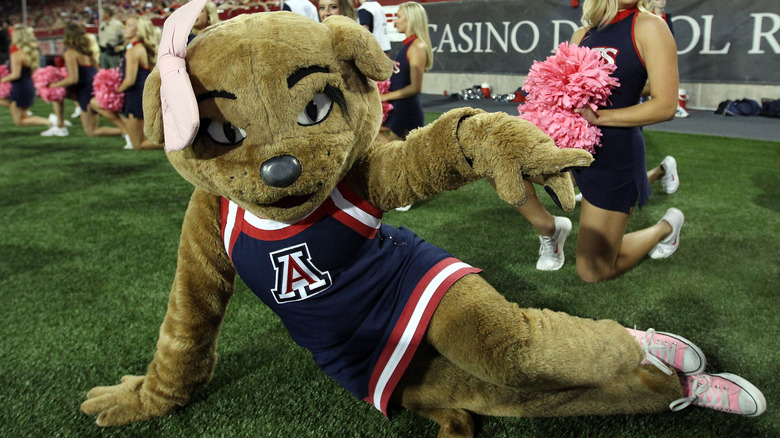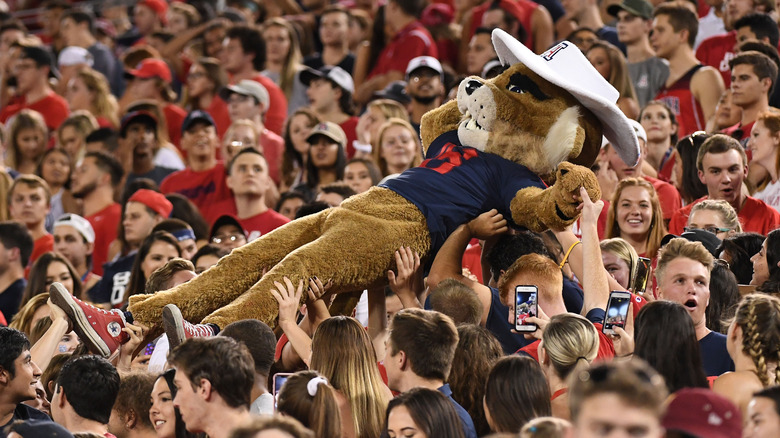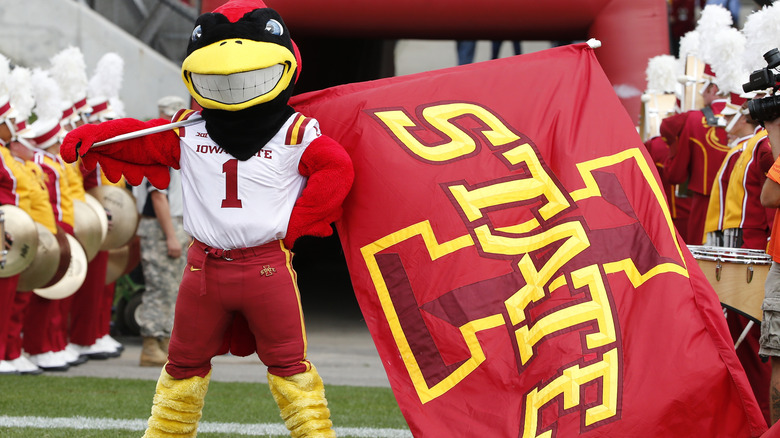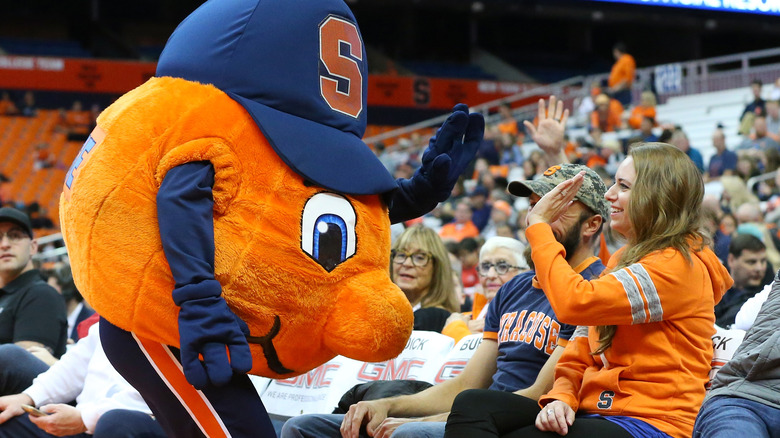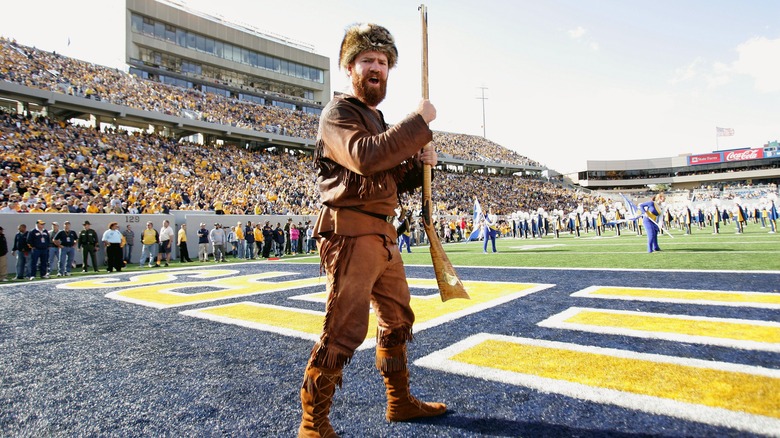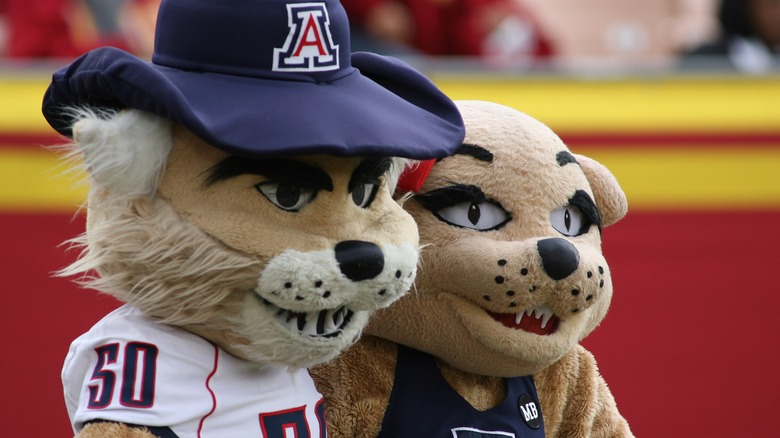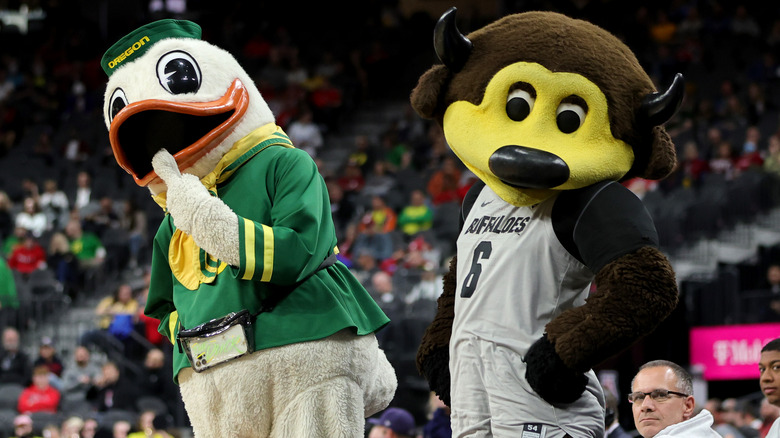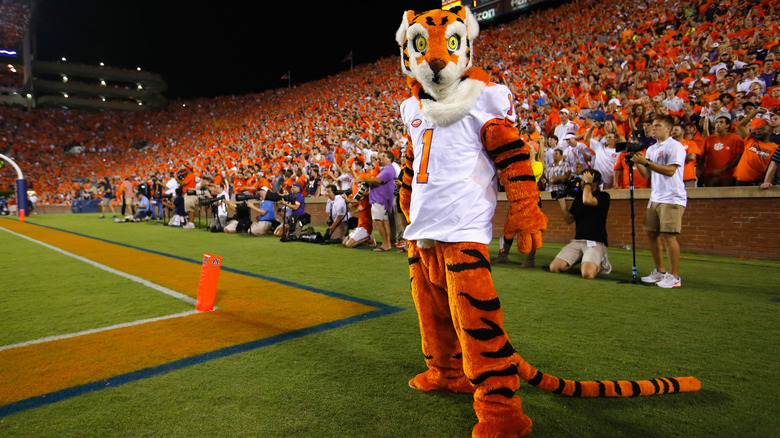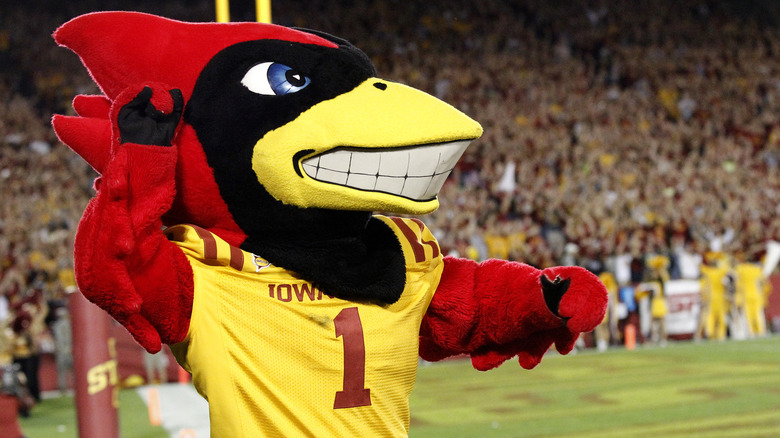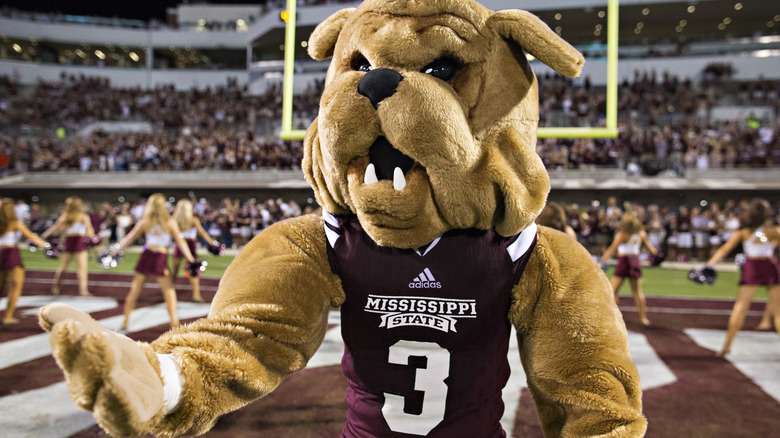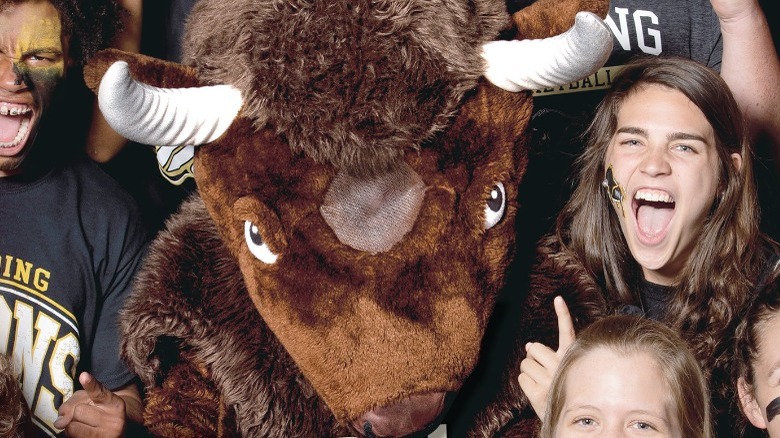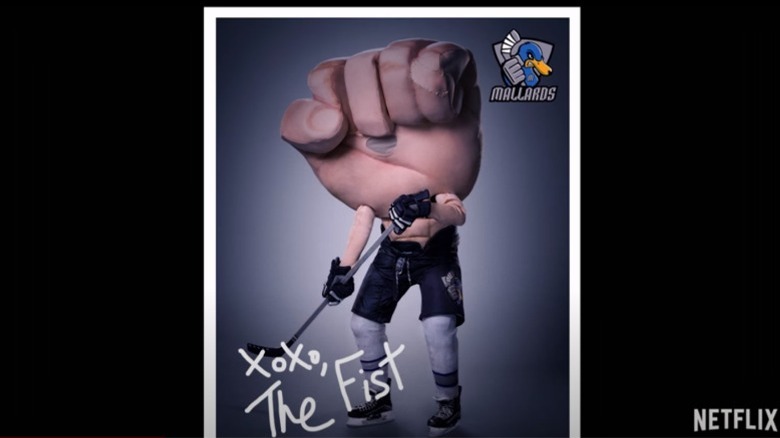What It's Really Like To Be A College Mascot
Going to a collegiate athletic event is arguably more fun than a professional one: There's just something about seeing your college's team on the field — and potentially knowing some of the players personally — that's pretty darn cool. It's no wonder students and alumni get super invested in games, and the actual sport is only part of the fun. Also important? The mascot.
They're the ones on all the merch and shirts, working the crowd into a frenzy, and embodying school spirit just as much as the team. And it seems like it'd be a fun job, right? Not only do they get a front-row seat to all the best games, but they also get to be the anonymous center of attention. (With, of course, a few exceptions, like West Virginia University's Mountaineer.)
So, what's it really like to don some of the most iconic costumes in the sporting world? Is it really all it's cracked up to be? And how bad do they really smell? While each individual school obviously has its own practices and procedures that make individual experiences a little different, let's look at what some of the people inside the costumes have to say about what it's like to be the spirit of their school.
What does it take to become a college mascot?
Being a college mascot isn't easy, and that's true right from the start. Just getting the job means going through a pretty rigorous process, and according to the University of Arizona's Wilma the Wildcat, her experience started with tryouts that lasted for an entire week of interviews and applications and culminated in donning the mascot suit for just seven minutes. In that seven minutes, applicants were expected to show just what they would bring to the games — and seven minutes, the anonymous Wilma said, wasn't that long to work the crowd.
Different universities have different tryout protocols, but they're all serious stuff. Anyone wanting to be Jackson University's mascot not only has to sign up ahead of time and provide proof of their GPA, but they also have to submit a $25 audition fee and be prepared for several days of clinics, skits, improv, and cheer routines.
And it makes sense: Not only does a mascot have to be able to dance, jump, and wiggle their way down the sidelines, but they have to do it all wearing a massive costume. And that's just the beginning. After he retired from being the University of Arizona's Wilbur the Wildcat in 2013, Forrest Gmitro talked about how fit applicants needed to be: "Sure, I might not be all that muscular-looking, but when you have to do over 250 one-arm pushups at a football game — well, come and talk to me."
Expect to be anonymous ... in most cases
Many college mascots can't reveal their identities, and according to former University of Arizona mascot Forrest Gmitro, it means that while the mascot might be having all these amazing college experiences, they can't actually tell anyone about it. "For us mascots, this can be a very hard thing to deal with, as secrets go," Gmitro said.
Another University of Arizona mascot — Wilma the Wildcat — explained a little more about just why there's such secrecy around the identity of mascots. They say that while it's partially about preserving the mystery of the character — it's about the mascot, not the person inside the costume — there's a dark side to it, too. "I've been stalked or harassed by people who found out not by my choice. It's pretty creepy."
Wilma says generally, mascots are unmasked at the end of their tenure, and then they're free to talk about their experiences. Those are people like Larry Lage, a former mascot for Michigan State. In a piece for The Seattle Times, he wrote that there was one more reason behind all the secrecy, and it basically has to do with college students — and diehard fans — being occasional jerks. As he says, "The last thing a mascot needs is his buddy trying to sabotage a performance."
(It's also worth noting that not all mascots are anonymous. West Virginia University's Mountaineer, for example, doesn't wear a mask, and North Alabama's lions, Leo and Una, are known on campus.)
There's usually more than one person donning the costume
When the Des Moines Register got an interview with Iowa State University's mascot, Cy, they weren't talking to one person. They were talking to a mascot squad that consisted of a handful of people who all took turns putting on the suit. That's not uncommon.
The University of Wisconsin-Madison, for example, has around eight people at a time portraying their Bucky Badger. The bottom line is that it's a logistical necessity: even with that many different mascot actors, each one still averages about 100 appearances a year. Over at Iowa State, they're hitting the 100 number, too, with each member of their squad spending about 100 hours a year inside the costume. Some other examples? The University of Findlay has either three or four people on-duty as Derrick the Oiler, and as noted by The U.S. Sun, the average for Division 1 schools is somewhere around four to five people named to mascot squads. The larger the athletics programs, the larger the commitment, and the more mascots needed.
Yes, the suit smells really, really bad
Iowa State University's mascot is Cy, and when he spoke to the Des Moines Register, he got candid. Like ... really candid.
To be more precise, those inside the suit for Cy got candid, because — as with many mascots — there's not just one person in there. That means wearing the suit isn't just marinating in your own funk, it's marinating in the funk of everyone else who's put it on recently. Even though they note that yes, the costume is cleaned regularly, that's not enough: According to Universal Cheerleaders Association mascot director Benji Gray (via Des Moines Register), the average temperature inside a mascot costume is between 20 and 50 degrees hotter than the outside temperature. And John Michael Collins — who was one of the many to don Cy's suit — said that the result was an added 10 pounds of water weight post-game.
Josh Kestenbaum, a former Roscoe the Lion for The College of New Jersey, confirmed to Today just how bad the costume smelled and said that if it was going to be a particularly long day for Roscoe, he'd try to be the first one up: "I could also never have imagined how bad it could smell inside that suit." A former Syracuse Orange put it another way in an interview with Casual Hoya: "The inside of the costume smelled like poop, because of the sweating, etc. I would not have noticed if someone had pooped in the costume."
It can mean big benefits when it comes to tuition
It's no secret that college is ridiculously expensive, and that's where mascots can get some serious perks. Many colleges have scholarship programs in place for the students who are appointed as their school's mascots, and just how much they receive can vary.
Lourdes University gives $1,000 per year to those portraying their Gubi the Gray Wolf mascot, while Columbia College hands out $1,500 each academic year in addition to paying students per appearance. Western Nevada College offers double that, with a $3,000 per year scholarship, and other schools — like the University of Wisconsin — also have scholarship funds established for their mascots.
Some schools hand out full scholarships to their mascots. Sam Houston State University doesn't give anything to students in their first year of putting on their furry orange costume, but for more experienced student mascots, they'll cover full tuition fees. West Virginia University waives tuition fees for their Mountaineer mascot (who carries a very real black powder rifle), and Saint Joseph's University gives their Hawk (who flaps his or her wings an average of 3,500 times per game) a full scholarship.
Expect to be wearing that suit a lot ... not just for games
College mascots might be most widely known for their game day antics, but that's just a small part of what they actually do.
Take it from the University of Arizona's Wilma the Wildcat. When she was asked what her favorite part of the job was, it wasn't football or basketball games at all, it was "Getting to do things outside of the university, because you get to see a lot of kids who may have never interacted with a mascot before." A high point in her mascot career was attending an All in for Autism event, where she was doing her wildcat thing at a drive-in movie. "In a way, we're not just the face of the university, we're the face of Tucson," she said.
Sam Houston State University asks a lot of its mascot, too. They're expected to attend everything from university recruitment events all the way up to alumni reunions. It's definitely not for the faint of heart, or for someone who thinks they might just be suiting up on game days. In 2021, WVNSTV spoke with West Virginia University's new Mountaineer, Colson Glover. The neuroscience student fulfilled a lifelong dream by being appointed as the school's mascot. Hard work? That doesn't even start to cover it. He gave the interview in September of that year and estimated that he'd already made somewhere between 300 and 400 non-sporting event appearances.
You're part of an elite club — and no, it's the opposite of rivalry
Every college has its rivals, and it would make sense that it's the same for mascots. But that's absolutely not the case, according to former University of Arizona mascot Forrest Gmitro. He says that it's not only the shared experiences that make mascots fast friends but the shared secret, too. When you're supposed to keep your identity under wraps, there's something awesome about meeting other mascots with the same struggles.
The then-current Oregon Duck explained: "When I met all of the other mascots for the first time at a Capital One commercial shoot it was literally like walking into a room full of your best friends for a surprise birthday party. We all talked for hours on end, sharing mascot stories, telling jokes, kicking back. It's amazing how fast you can create such a strong bond with complete strangers."
Gmitro says it's the same when they meet on game day and oftentimes, mascots — even those from rival colleges — will hang out behind the scenes and plan game day routines ahead of time. When teams travel to away games, it's a given that mascots are also going — and the shared experiences they have mean that it's often fun times and friendship when they get together ... out of the suit, at least.
Interacting with fans isn't always great
In 2010, The Bleacher Report spoke to then-Clemson Tiger mascot Michael Speer. While he said that not being allowed to talk while wearing the tiger suit made it easier to interact with fans, doing so wasn't always a good experience. He recounted one instance where he was accosted by a drunk, middle-aged man asking for his autograph. When he declined, "he grabbed me, spun me around and kicked me in the knee. So at that point I went and got a cop and had the man escorted out."
Some of the stories are downright terrifying such as the tale told by the Syracuse Orange. One of Penn State's cheerleaders whipped the crowd into a frenzy, and the Orange was grabbed and forcefully crowd-surfed along. "I got about 8 rows up and someone ripped off the head of my costume, stole my shoe, and started taking my pants down," he recalled in an interview with Casual Hoya. "They then dropped me on the bleacher. ... Security had to escort me to the locker room."
Her Campus spoke with Hofstra University mascot Kate, who said one of the worst parts of being a mascot was the fans that got carried away. She wished more knew that what might seem like a harmless tap or shove wasn't harmless at all: "There's a human in there. Unfortunately, we are not walking animals. Treat us nicely!"
For introverts, it's game on
AJ Mass is a former Mr. Met mascot and spoke with the Des Moines Register on why college mascots are so popular. He explained that a big part of it is that they're a character that lives on long after alumni have graduated and moved on with their lives, and there's something comforting about that. But what makes a mascot want to be the one to don the suit?
There are typically two types of people who go for being a mascot, Mass says: the extreme extrovert and the extreme introvert. The former makes sense, but the latter? Iowa State University mascot John Michael Collins explained it this way: "I hate being the center of attention as a person, but when I'm mascoting, it's not me that is the center of attention, it's Cy. It's still me inside the suit, and it's still my personality, but everybody just sees the mascot."
Mass says that putting on the suit is transformative for many, who often discover a whole new outlet for expressing their personalities that they might not be comfortable doing when they're in their own skin. Josh Kestenbaum — formerly a mascot for The College of New Jersey — echoed those sentiments to Today. "When you are in the suit, you almost have to let go of who you are and become the mascot."
There's a real danger of some terrible injuries
Being a college mascot isn't all fun and games, and there's a potential for serious injuries. In 2015, WCBI reported that Mississippi State University and ESPN were being sued by a former mascot who had been hit by a television cart while she was on the sidelines of a game. The resulting compound leg fracture meant mounting medical bills, leading to her $500,000 claim. Perhaps unsurprisingly, head injuries can happen, too. In 2022, The Spun reported that Ohio State mascot Brutus the Buckeye had left a game early after being injured in a hamster ball contest. After being shoved, he was taken to the team's locker room to be checked for a possible concussion.
When HealthDay compiled statistics on the injuries most commonly reported by mascots at all levels, they found that mascots tended to get hurt about as often as college basketball players. Most common complaints included heat exhaustion, head and neck injuries, back injuries, sprained ankles, and knee injuries. Around 12% of injuries suffered by mascots across the board required surgical intervention, and many of the injuries were inflicted by either players or fans.
It can be life-changing
For some, donning the costume of a beloved college mascot can be life-changing. Take the story of Austin Dunning. He, reports KATV, is Harding University's Buff the Bison, and in 2019, he was in his ninth year as the school's mascot. Diagnosed with autism, Asperger's, depression, and anxiety, Dunning started being a mascot in high school, and then? He never looked back. He went on to be Freddy the Cougar at Frederick Community College in Maryland before enrolling in Harding and becoming Buff the Bison. His mother — and mascot coach — explained, "Once that headpiece is on, that is truly his comfort zone. Everything else goes away."
Dunning isn't alone. In 2022, CBS Philadelphia spoke with Paul Anderson, who had spent much of his time at Martin Luther King High School in the cougar mascot costume. Anderson is also on the autism spectrum, and teacher PennySue Gold-Laster explained that for someone who had difficulties with verbal communication, being a mascot was a brilliant way to communicate in an entirely different way. During the interview, he also had a pretty awesome visitor who could talk to him about the life of the mascot: the Phillie Phanatic. That, after all, is what being a mascot is all about.
Want to know what it's like? Watch this show
Interested in the life of a college sports mascot? Wondering if it's for you? For anyone wanting to do a fun kind of research, there's a film on Netflix that Josh Kestenbaum says is actually pretty accurate. Kestenbaum — who formerly donned the very stinky suit to portray The College of New Jersey's Roscoe the Lion — told Today that when he turned into the Christopher Guest mockumentary "Mascots" he was sold when they referred to the smell inside the suit as having the distinct aroma of a porta-potty.
"Mascots," summarizes Vox, is the story of a group of semi-professional sports mascots who are competing in what's sort of the Oscars for mascots. Starring Parker Posey (as Alvin the Armadillo) and Chris O'Dowd (as The Fist), Kestenbaum says that it's a hilariously truthful look at what it's like to be a mascot. Kestenbaum adds that it was the quote at the end (and don't worry, no spoilers) that absolutely summed up what it was like to be a mascot ... in a way. The quote was simply, "It's an outfit," but Kestenbaum elaborates that for those who have lived the life and walked the walk, those three words take on much, much more meaning: "It is just an outfit. But it's an outfit that comes with a certain mentality and personality that you, as the person in the suit, have to take on and live up to."
